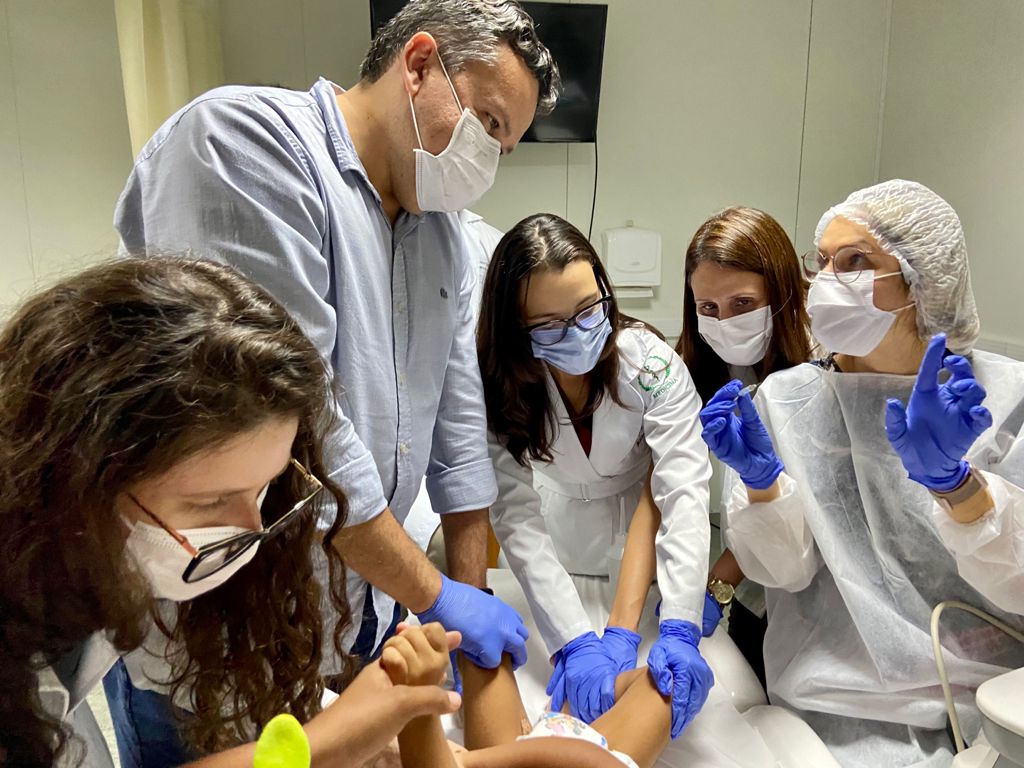Popularly associated with use in aesthetic procedures, botulinum toxin, commonly known as Botox, has functions that go beyond improving physical appearance. For the first time, patients who use motor rehabilitation services at the Santos Dumont Institute (ISD), in Macaíba, received applications of the toxin to treat spasticity, which is a common disorder in congenital or central nervous system injuries, which can cause functional incapacity, deformities and pain. Botulinum toxin acts to reduce spasticity and inhibits, for a period of time, the mechanism that increases reflex contraction.
Named the Specialized Multidisciplinary Service for the Treatment of Spasticity (Semente), the outpatient clinic is staffed by a multidisciplinary team consisting of physical therapist Camila Simão; biochemist and pharmacist Danielle Alecrim; pediatric orthopedic surgeon Kalyana Fernandes; and neurologist Ângelo Raimundo da Silva Neto. They treat patients from the Specialized Rehabilitation Center (CER IV) who are indicated for spasticity treatment, located at the Anita Garibaldi Health Education and Research Center (Anita). On the first day of operation of the outpatient clinic, last week, three patients received the toxin. Most of the applications performed so far have been in the lower limbs, where most of the involuntary muscle contractions that occur in the children treated are concentrated.
According to Camila Simão, the treatment initiated with botulinum toxin is pioneering because it involves a multidisciplinary team that discusses, according to the demands and needs brought by the family, the indication for application and the rehabilitation process. Before the medication itself is administered, all patients with an indication for treatment are evaluated by these professionals who, by consensus, approve or disapprove the use of the substance. The start of the service at Anita was made possible by an agreement signed between the Santos Dumont Institute and the State Department of Public Health of Rio Grande do Norte (SESAP/RN). Based on this agreement, the medication, named after the patients, is sent for storage at Anita.
“Anita stores the botulinum toxin in a suitable environment, with controlled temperature and with minimal risk of loss of units. All with the aim of optimizing the effects of the application”, emphasizes Camila Simão. The items are only sent to Anita after they have been dispensed by the Central Unit of Therapeutic Agents (Unicat) on behalf of each patient. In addition to being a pioneer in the issue of a multidisciplinary outpatient team, Anita uses virtual reality glasses on some children so that they can be distracted while the medication is administered.
According to Kalyana Fernandes, a medical preceptor in Pediatric Orthopedics, the physical aspects of the patients are studied to define in advance the best form and ideal dosage of Botox to be applied. “There is a clinical study in advance to define the dosage to be applied. The dosage depends on the weight and the clinical neurological evaluation. Botulinum toxin is not indicated for all cases. In some cases, clinical treatment and neurosurgery are more appropriate alternatives. This treatment (with Botox) brings great benefits to the patient”, explains Kalyana Fernandes. She also highlights that the reaction to the product does not occur frequently and that it is similar to a vaccine reaction. The use of medications such as paracetamol or dipyrone is recommended to relieve symptoms.
Text: Ricardo Araújo / Ascom – ISD
Photograph: Ricardo Araújo / Ascom – ISD
Communication Office
comunicacao@isd.org.br
(84) 99416-1880
Santos Dumont Institute (ISD)
It is a Social Organization linked to the Ministry of Education (MEC) and includes the Edmond and Lily Safra International Institute of Neurosciences and the Anita Garibaldi Health Education and Research Center, both in Macaíba. ISD's mission is to promote education for life, forming citizens through integrated teaching, research and extension actions, in addition to contributing to a fairer and more humane transformation of Brazilian social reality.















